Game Review: Tomb Raider (PS1)
1996 was a year of transition for gaming, funnelling players from the two-dimensional adventure titles of yesteryear to the far more robust sense of immersion provided by three dimensions. From the platforming brilliance of Super Mario 64, to the unsettling tension of Resident Evil’s Spencer Mansion, gamers worldwide were in awe of what was now possible. One such ground-breaking game was Tomb Raider, created by Core Design in the small Midlands city of Derby and since immortalized by numerous sequels and countless citations of its influence. By taking tropes from movies such as Indiana Jones, harnessing the power of the Sony Playstation, and providing gamers with the rare novelty of a female protagonist, Core developed something timeless.
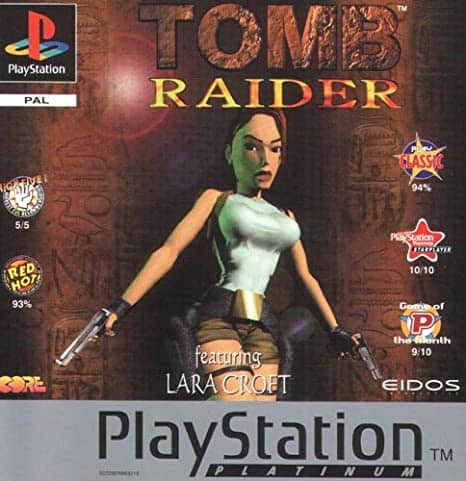
When settling down to play this relic of the past from a modern perspective, one thing immediately discernible is the compelling sense of wonder evoked from its earliest moments. Witnessing a cinematic of a woman suspended by a rope far above the ground, only to perform an acrobatic stunt to land and fire upon a pack of wolves previously hidden by a colossal door in a bid to save her travelling companion is a thrilling introduction to a selection of levels that feel carefully constructed and connecting via a logical structure.
Tomb Raider’s blend of key-based puzzle solving, furious combat with wild beasts, and secret hunting does not alternate between ten-plus vastly differing locations with no explanation as to how or why heroine Lara Croft arrived at them. Rather, the opening gauntlet of this game is segmented into a cautious exploration of the Caves, then a wondrous quest to open the central door within the City of Vilcabamba, culminating in a descent into The Lost Valley.
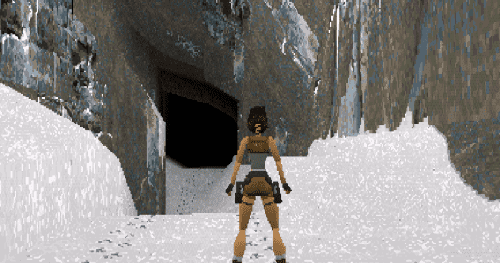
This is one of those unforgettable gaming moments in which our protagonist, in her goal to find the first titular tomb, passes more wolves before traversing a cliff and lowering herself into a beautiful grassy landscape inhabited by terrifying dinosaurs. No, that was not a typo; dinosaurs. Upon retrieving three cogs from this area and shutting off a stream causing a waterfall, the tomb is finally revealed and Lara is free to continue her journey, yet the player’s mind is now fixated on one thing : what other phenomena could be present within this game?
Moments like these permeate a first playthrough of this game, yet impressive set pieces are nothing without smooth gameplay and a strong technical backdrop to convey them. Miraculously, Core Design succeed on all fronts here.
Throughout her mission to retrieve various pieces of an ancient artefact, Lara is challenged by a near-endless variety of obstacles to pass, and so the movement options here are required to be tight. Lara can jump, utilize a run-up to leap further distances, grab onto ledges, roll to avoid dart traps and switch her focus to enemies behind her, and slow her movement to walking speed with the use of a specific input. Skilled players can mix these commands together to hurdle the sheerest ascents rapidly, whilst the more cautiously-minded adventurer may prefer to take each fresh challenge slowly and methodically.
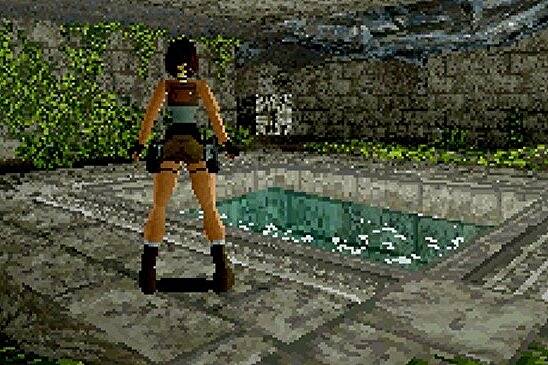
The combat is not especially in-depth, simply relying on holding the fire button, yet the integration of new weapons at key points in the story adds nuance to certain situations. Whilst firing, the use of backflips and rolls is mandatory, as is motion to avoid some of the tougher foes that can end Lara’s life in seconds. It is this frailty that spurs the player on to explore and find each level’s three secrets, in the hope that they might alleviate some of the risk of damage by giving a health pack or some ammunition for Lara’s heavier weaponry.
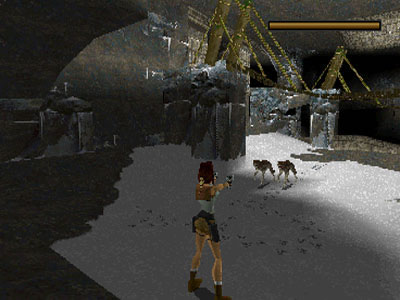
Whilst visibly the most dated aspects of Tomb Raider, the technical components of this game have aged remarkably well when placed alongside other games from the era. Each of the levels is designed on a skeleton of cubes, each colored to represent different types of terrain, with primitive billboards dotted across the landscapes to give the appearance of trees and golden idols, to name but a couple. These give the environments a crude and simplistic look, with clear technical limitations that break up upon close inspection, yet each level feels unique and attractive in their own way.
Artwork adorns the wall textures of various tombs, and stable equipment can be found within the City of Vilcabamba to give the impression of locales that have been lived within. When one takes into account the brutal wildlife and creatures found within, each level is its own hostile death trap lended a tense and atmospheric component by the black fog that extends into the distance – a clever performance-saving trick that functions similarly to the fog from Silent Hill. Lara’s character model is a real highlight here, as are the animations through which she interacts with the environment.
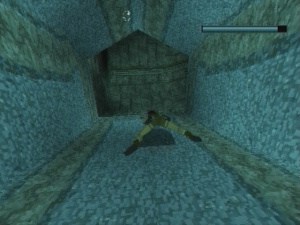
Be it the swing of a leg, or the action of reaching into her backpack and twisting a key in a lock, Core Design found a way to make each movement feel as though there is real weight to it, selling some semblence of realism to the player. The sound design adds to the tension, with Lara’s footsteps heavily breaking the eerie silence until an enemy is encountered, when a thrilling track will play in the background. Extra praise must go to the title screen score, which is highly soothing and remains stuck in my head for days at a time.
Core Design really struck gold with Tomb Raider, and its continual presence on the world stage says more than a review ever could. This series has been rebooted twice, with the most recent “Survivor Trilogy” introducing new audiences to one of gaming’s most iconic heroes. Multiple versions of the original game exist, with the Saturn version running at a lower frame rate than the Playstation version, and the Steam version using DOSbox to facilitate modern computers.
The Sony console is the most widely known version, and the preferred way to play overall, but the DOS version comes in a close second and is significantly cheaper than the £20 required to pick up a Complete copy of the Playstation version. Regardless, this is a brilliant experience with all its charm and wonder remaining intact almost thirty years later. The aged visuals, and the use of fixed camera angles detract a little when scrutinized now, but it is still an essential game from a tranformative time period for the industry.
Tomb Raider (PS1)
-
The Final Score - 9/10
9/10



